**ORIGIN and EVOLUTION of the Sardinian traditional dress**
This is not an easy topic at all but we'll try putting some order.
📸 Gruppo folk Seneghe #Sardinia
This is not an easy topic at all but we'll try putting some order.
📸 Gruppo folk Seneghe #Sardinia

We have sources of traditional dresses starting only since XVIII century, drawings of travelers and later on photographs. We have little to no information about medieval times and some paintings for later centuries.
We don't have any reason to think people in Middle Age dressed-
We don't have any reason to think people in Middle Age dressed-
-differently than in the rest of Europe. In fact many female head coverings still look similar to the medieval ones, here portrayed. 







We see here Mariano in his knighthood dress and his daughter (of Catalan mother) Eleonora in a medieval dress with flower buttons, kerchief on the head (precursor of mantilla?). Her brother Ugone wore white leather gambals, in the "Sardinian way". They loved good Catalan fabrics. 



Similar medieval head pieces, also pinned in the same way - to hats or kerchiefs underneath - are part of Sardinian traditional dresses. Osilo's dress still shows a typical medieval soggolo.
📸 Atzara, Meana Sardo, Ollolai, Osilo



📸 Atzara, Meana Sardo, Ollolai, Osilo
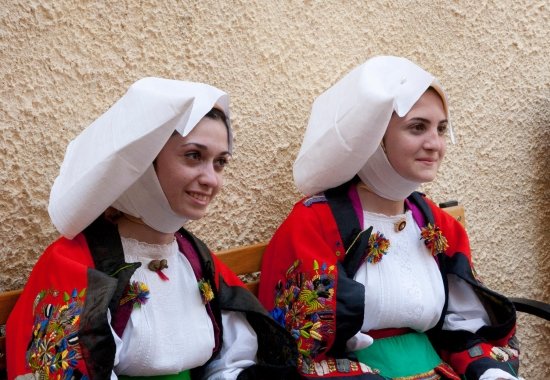



Bands are used in the most conservative dresses, like Nuoro and Orgosolo. The band was meant to cover the chin and sometimes the mouth too. It is the most elegant version of the dress.
Last picture shows old dress of Tempio in background-
📸 Nuoro, Orgosolo, Sennori, Tempio.



Last picture shows old dress of Tempio in background-
📸 Nuoro, Orgosolo, Sennori, Tempio.




-and more recent version in foreground. Medieval soggolo is still there.
We move ahead in centuries and see these beautiful Italian dresses with sleeve openings. It was the time for detachable sleeves and white shirt showing. We see this fashion also in later Baroque Spanish-



We move ahead in centuries and see these beautiful Italian dresses with sleeve openings. It was the time for detachable sleeves and white shirt showing. We see this fashion also in later Baroque Spanish-




-fashion, for both men and women. Spanish fashion was the European fashion of XVII century.
We find sleeve openings in many Sardinian dresses (here for male clothes), including the older versions of the southern ones.
📸 Some Spanish guy, Nuoro dress

We find sleeve openings in many Sardinian dresses (here for male clothes), including the older versions of the southern ones.
📸 Some Spanish guy, Nuoro dress


Clear cuts in the traditional dresses of Oliena and Dorgali. These look especially like the Renaissance ones. Nuoro has great cuts too.
Now, one thing that must be clear is that when looking at traditional dresses, we're not looking at things from the same period. Dresses of-

Now, one thing that must be clear is that when looking at traditional dresses, we're not looking at things from the same period. Dresses of-


-Barbagia are older because they changed less in time. Dresses from the south or the coasts followed more the European fashions. We also see that older dresses have brighter colours, like these.
📸 Aritzo, Desulo, Orgosolo (gala and half-mourning), Atzara.



📸 Aritzo, Desulo, Orgosolo (gala and half-mourning), Atzara.




The dress of Orgosolo still shows embroidery in the apron that recalls ancient glyphs in Prenuragic menhirs of Laconi. Dresses like Orgosolo and Nuoro still wear the corset *over* the jacket, like the oldest Campidanese paintings. Older corsets show two spikes-
📸 Gavoi, Fonni

📸 Gavoi, Fonni


-in the front that we don't know where they come from. Other dresses have these spikes in the jacket.
📸 Sarule.
📸 Sarule.

Campidanese dresses show huge frills around the neck, in almost Baroque taste. In Barbagia they are smaller.
📸 Selargius, Spanish Baroque fashion

📸 Selargius, Spanish Baroque fashion


This picture I don't know where is from but the head piece reminds the peculiar one of Samugheo and also the very early Campidanese corsets. 


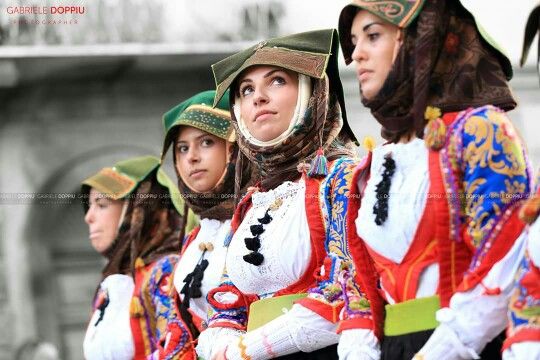
We arrive at a point where suppositions are left behind and fashion historians have something to work with, verifiable and verified.
These are Spanish traditional dresses. It is commonly accepted Sardinian dresses derive from a strong Spanish influence, just like the jewels--


These are Spanish traditional dresses. It is commonly accepted Sardinian dresses derive from a strong Spanish influence, just like the jewels--



-which we see starting from the XVIII century.
First drawings show bright colours. Drawings of XIX century show skirts enlarging with the European fashion of the crinoline. Sardinian women didn't have crinoline, they used several skirts. Still today, Maracalagonis' dress -



First drawings show bright colours. Drawings of XIX century show skirts enlarging with the European fashion of the crinoline. Sardinian women didn't have crinoline, they used several skirts. Still today, Maracalagonis' dress -




-requires two skirts. When the crinoline was substituted with the crinolette, at the turn of the century, Sardinian dresses take that shape, like in Ploaghe ⬇️, with a kind of cushion. 



These are Spanish traditional dresses of the same century, 1800s. We see here a piece that will have great importance in southern Sardinia: the shawl crossed over the breast. 



Dresses of the south, especially of the neighborhood of Cagliari, thanks to the wealth of the locals, are the ones who can keep up with European fashion. Dark colours are preferred, corsets are hidden under a closed jacket or an additional piece.
📸 Campidano of Cagliari


📸 Campidano of Cagliari



Muslin veils with fringes take the place of kerchiefs.
To get rid of the cumbersome parts during everyday life and to protect from sunburn and malaria (people were mostly farmers), women and men too used to tie the endings over the head.
To get rid of the cumbersome parts during everyday life and to protect from sunburn and malaria (people were mostly farmers), women and men too used to tie the endings over the head.

The evolution of the dress of the Sulcis-Iglesiente. First picture: sa massaia antiga is the oldest version, now used only in Sant'Antioco. The newer dress is sa nostrada, in light blue for the beginning of 1800 and royal blue at the end of the century. This mantilla is- 





-basically identical (with inverted colours) of that of women from Roncal in Navarra.
In the background you see instead the everyday dress.
📸 Massaias antigas, Roncal


In the background you see instead the everyday dress.
📸 Massaias antigas, Roncal



The evolution of the dress of Bitti, in Barbagia. First one is 1800s version, the central is without veil (probably half-mourning) with head piece similar to that of Ollolai, the last is with the addition of muslin and silk veils. 





But what about men? Travellers of the beginning of 1800s already speak of the leather cojettu as something disappearing. It was the apron of farmers and now only used in the Carnival mask of su Componidori of Oristano. 



Men have a peculiar piece which are the ragas, short skirt-like breeches, somewhere shorter, somewhere with tighter pleats. Their origin is open discussion because they're not found elsewhere: some say they resemble the skirts of Nuragic statuettes, other think of a separation- 

-of the male tunic as it happened for women too.
A variation is the long breeches of the men of the Sulcis-Iglesiente, which gave them the name of meurreddus because apparently they looked like ravens 😂 (meurra = raven).
A variation is the long breeches of the men of the Sulcis-Iglesiente, which gave them the name of meurreddus because apparently they looked like ravens 😂 (meurra = raven).

Men from the Campidano of Cagliari could afford a richer outfit and we can see here variation of colour, fabric, headbands and s peculiar jacket that is su sereniccu.
Si sereniccu was introduced by a group of Corsican Greeks who emigrated in Cagliari between 700s and 800s and-

Si sereniccu was introduced by a group of Corsican Greeks who emigrated in Cagliari between 700s and 800s and-


-started producing this jacket that Sardinians loved. Sereniccu is a distortion of Salonicco.
The high red hat of militiamen in Cagliari reminds also of Greek influences, but we also have Sardinian red hats similar to that, probably of Genoese inspiration?
The high red hat of militiamen in Cagliari reminds also of Greek influences, but we also have Sardinian red hats similar to that, probably of Genoese inspiration?
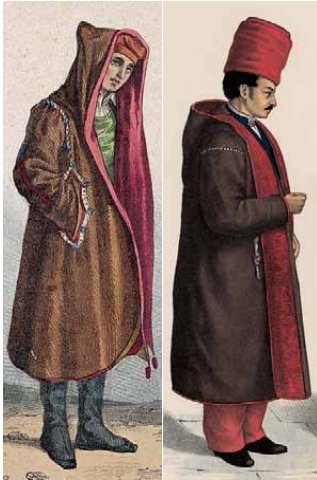
Here we have a man from Sassari, which had a lot of Genoese influence in history, s painting of a saint by a Sardinian artist and a man from Tresnuraghes. To remind Sardinian men wore braids 😂 





Finally, with the world wars, people from everywhere in Italy started sharing common clothes.
These are transitional dresses which are still considered historical and dating from early 900s ahead. Men started wearing trousers, women large skirts and simple shirts.
📸 Seneghe



These are transitional dresses which are still considered historical and dating from early 900s ahead. Men started wearing trousers, women large skirts and simple shirts.
📸 Seneghe
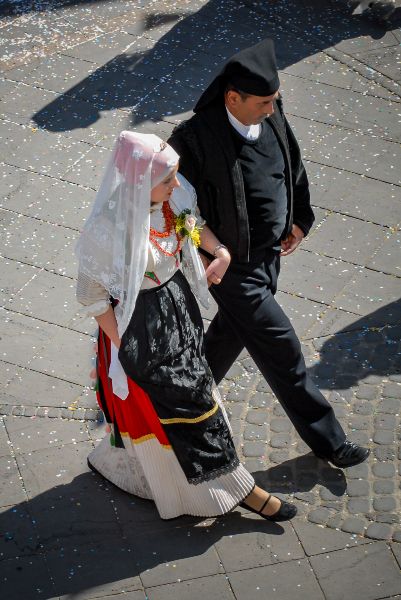



These are two famous pictures: a group of Sardinian women going on a strike and a lady with Desulo traditional dress getting gas. 



Black has always been the colour of mourning and here we see widows who covered most of themselves and then slowly showed more.
📸 Ossi, Aidomaggiore, Ossi half-mourning


📸 Ossi, Aidomaggiore, Ossi half-mourning

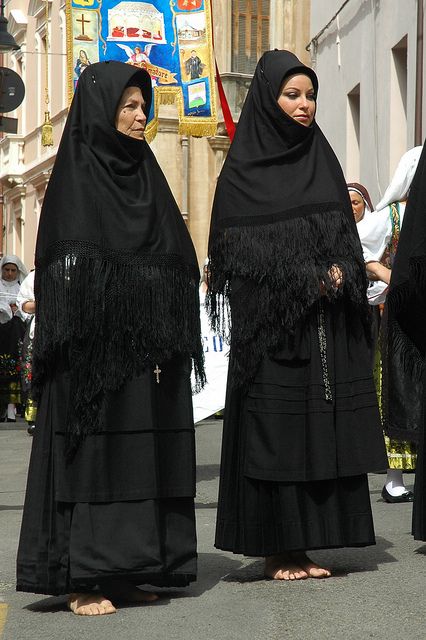

Picture out of chronological order but I found it now 😂 This is the first picture of a Sardinian traditional dress. Portrait of Maria Piras, woman of the area of Cagliari, 1725. The corset is over the jacket. 

New addition: old dress of Oliena, around 1700. Note the richness of colours, the apron much similar to the others of Barbagia, corset over jacket and the absence of the shawl. Shawls were in fact added only since early 1800s, when they became fashionable in Europe. 

• • •
Missing some Tweet in this thread? You can try to
force a refresh
















